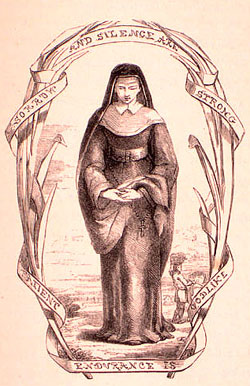
|
|
Although it sold in the tens rather than the hundreds of thousands of copies, Longfellow's Evangeline was one of the most popular poems in American literary history. Like Stowe's novel, its central character is torn away from home and family. Unlike Tom, who is carried south against his will, Evangeline travels south and west across the American landscape on her own quest for her lover. Both, however, come to accept their unhappiness as the will of God to which they must submit.
Included in the selections below are six illustrations from the 1850 deluxe edition of the poem published to exploit its popularity. In her depiction of the Acadians being driven into exile (Part I, Section V), Jane E. Benham chose to put the men in chains. This detail is not in Longfellow's text, and the image suggests that it was possible to associate this eighteenth-century story with nineteenth-century images of American slavery. Hawthorne had a different reaction to the illustrations. After Fields sent him a copy of the deluxe edition, he wrote back to say that Benham's "representations of the heroine have suggested to me a new theory" about the poem: "Evangeline is so infernally awkward and ugly . . . that Gabriel was all the time running away from her, . . . when she at last caught him, it was naturally and inevitably the instant death of the poor fellow."
[text:] Evangeline, A Tale of Acadie, by Henry Wadsworth Longfellow (Boston: William D. Ticknor & Company, 1847).
[illustrations from:] Evangeline . . . Illustrated with Forty-Five Engravings on Wood from Designs by Jane E. Benham, Birket Foster, and John Gilbert (Boston: Ticknor, Reed, and Fields, 1850)

|
|
